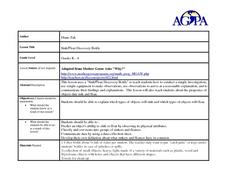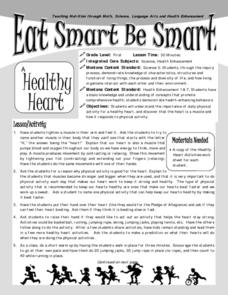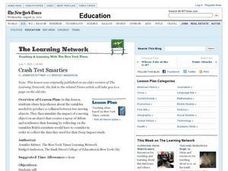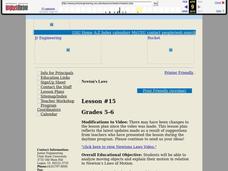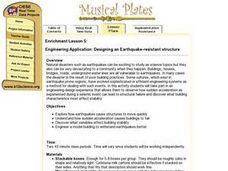DiscoverE
Shake It Up with Seismographs
Shake up your lessons on earthquakes. A simple seismograph lets scholars record "earthquakes" in the classroom. These earthquakes occur when classmates drop balls from different heights. Young scientists measure these with seismographs...
Teach Engineering
Exploring Energy: Energy Conversion
The energy is not really lost, it is just converted to a different form. Pupils learn about the conversion of energy in the fifth segment of an energy unit with six parts. Learners develop an understanding of the conservation of energy...
Curated OER
Ball Identification Exercise
Fourth graders participate in a ball identification exercise to help them identify birds. As a class, their teacher throws them a variety of different sized and colored balls for them to describe. Using these factors, they work together...
Curated OER
Fusion Confusion
Students are introduced to three types of energy transfer: conduction, convection, and radiation. They model the scientific process of fusion to become with the sun and how it produces energy.
Curated OER
Sink/Float Discovery bottle
Investigate which items float and which ones sink using this resource. Learners participate in an activity in which they investigate this phenomena. Then they describe the experimental process, and learn how to display their results.
Curated OER
How Can You Tell One Clear Gas From Another?
Fifth graders perform experiments to determine the identity of an unknown gas sample. In this chemistry lesson, 5th graders fill balloons with air, oxygen, hydrogen, and carbon dioxide. They use mass and reactivity to identify the gases.
Montana Office of Public Instruction
Eat Smart Be Smart
Get children's blood pumping with this primary grade activity on the human heart. After learning about the important role this muscle plays in the human body, learners monitor their heart rates and discover the importance of staying active.
Curated OER
Understanding the Rutherford Model
In this Rutherford model worksheet, students read about Rutherford's experiment with gold foil and alpha particles which led to the discovery of subatomic particles. Students answer six analysis questions about the experiment and...
Curated OER
Striking: Accuracy and Power
Students gain an understanding of the concept of accuracy and power as it relates to the length of striking implements used.
Curated OER
Cardiac Maze
Students participate in a role-play activity to lean about red and white blood cells, veins, capillaries and arteries. They also see how blood passes through the heart, lungs and out of the body, carrying oxygen and nutrients.
Curated OER
Droplets and Downpours
Students explore how storm water flows through different habitats by sketching the slope of their yard, compare runoff for erosion, and create a sand castle. In this storm water lesson plan, students measure where their yard started and...
Curated OER
Electric Charge
Students discover and identify positive and negative electrical charges and understand that like repels and opposite charges attract. In this physics lesson, students observe how friction can be used to give electrical charge to various...
Curated OER
Crash Test Smarties
Students share hypotheses about the variables needed to produce a collision between two moving objects. They simulate the impact of a moving object on an object that creates a spray of debris, and simulate a NASA Deep Impact study.
Curated OER
THE PHYSICS OF MOVING THINGS (AND NOT A MOMENTUM TOO SOON!)
Learners list three examples of momentum found in their local environment; describe the importance of mass and velocity on momentum; and determine what is necessary to produce the greatest amount of momentum within a particular system.
Curated OER
Where Will It Go?
Students attempt to determine where a ball will travel when it is bounced. They set up an experiment in which they predict the line a ball will follow when it hits an object and bounces off. They draw the line that predicts where the...
Curated OER
TE Lesson: Energy Transfer in Musical Instruments
Students study concepts of energy and energy transfer. They look at how these concepts apply to musical instruments. They study the law of conservation of energy. They use the concepts studied in the lesson to design a musical instrument.
Curated OER
Panning for Gold and Magnetite
Learners pan for minerals in a stream and discover why magnets attract magenitite but not nonmagnetic grains. They participate in the actual panning process and bag samples to be examined in class. Students recognize minerals by color...
Curated OER
Goop to geoforms
Students illustrate geographical terms in three dimensional form. They use magic modeling goop and paint to create features of the geographic landscape. Students explain the meaning of geographical terms.
Alabama Learning Exchange
Our Restless Planet
Students examine the topic of the Earth's rotation, revolution, and orbit. They observe teacher-led demonstrations, explore various websites, write journal entries, conduct a demonstration of why Earth experiences day and night, and...
Curated OER
Newton's Laws
Students experiment with and analyze moving objects and explain their motion in relation to Newton's Laws of Motion. Students then work with partners to design and construct cars that are powered by balloons.
Curated OER
Creating an Enzyme-Substrate Model
Students explore the reaction rates of an enzyme-mediated reaction through experimentation. In small groups, they use everyday objects to demonstrate the effects of environmental variables on enzyme function.
Students graph and...
Curated OER
Designing an Earthquake-resistant Structure
Students attempt to design and build the most stable "earthquke resistant" structure. They create model buildings and test them on a shake table to see which design holds up the best.
Curated OER
Animal Classification
Third graders differentiate between vertebrates and invertebrates, and identify the main characteristics of mammals, fish, reptiles, amphibians, and birds. They sort and categorize different types of balls, discuss the characteristics...
Curated OER
Structure and Function
Structure and Function
SynopsisStudents choose some biological object, examine its structure, and identify or speculate on one particular function. Next they create a blueprint of the object, focusing on the particular function. Then...
Other popular searches
- Table Tennis
- Tennis Lesson Plans
- Tennis Ball
- Tennis Drills
- Bouncing Tennis Ball
- Tennis Forehand
- Tennis Test
- Floor Tennis
- Tennis Serve
- Tennis Skills
- Tennis Scoring
- Education Tennis






